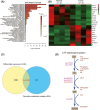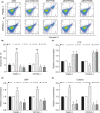Identification of ENTPD8 and cytidine in pancreatic cancer by metabolomic and transcriptomic conjoint analysis
- PMID: 29987902
- PMCID: PMC6125470
- DOI: 10.1111/cas.13733
Identification of ENTPD8 and cytidine in pancreatic cancer by metabolomic and transcriptomic conjoint analysis
Abstract
To identify metabolic pathways that were perturbed in pancreatic cancer (PC), we investigated gene-metabolite networks by integration of metabolomic and transcriptomic. In this research, we undertook the metabolomic study of 43 paired human PC samples, aiming to identify key metabolic alterations in PC. We also carried out in vitro experiments to validate that the key metabolite cytidine and its related gene ENTPD8 played an important role in PC cell proliferation. We screened out 13 metabolites differentially expressed in PC tissue (PCT) by liquid chromatography/mass spectrometry analysis on 34 metabolites, and the partial least square discrimination analysis results revealed that 9 metabolites among them were remarkably altered in PCT compared to adjacent noncancerous tissue (variable importance in projection >1, P < .05). Among the 9 metabolites, 7 might be potential biomarkers. The most significantly enriched metabolic pathway was pyrimidine metabolism. We analyzed 351 differentially expressed genes from The Cancer Genome Atlas and intersected them with Kyoto Encyclopedia of Genes and Genomes metabolic pathways. We found that ENTPD8 had a gene-metabolite association with cytidine in the CTP dephosphorylation pathway. We verified by in vitro experiments that the CTP dephosphorylation pathway was changed in PCT compared with adjacent noncancerous tissue. ENTPD8 was downregulated in PCT, causing a reduction in cytidine formation and hence weakened CTP dephosphorylation in pyrimidine metabolism.
Keywords: metabolic pathway; metabolite; metabolomic; pancreatic cancer; transcriptomic.
© 2018 The Authors. Cancer Science published by John Wiley & Sons Australia, Ltd on behalf of Japanese Cancer Association.
Figures





References
MeSH terms
Substances
Grants and funding
LinkOut - more resources
Full Text Sources
Other Literature Sources
Medical

